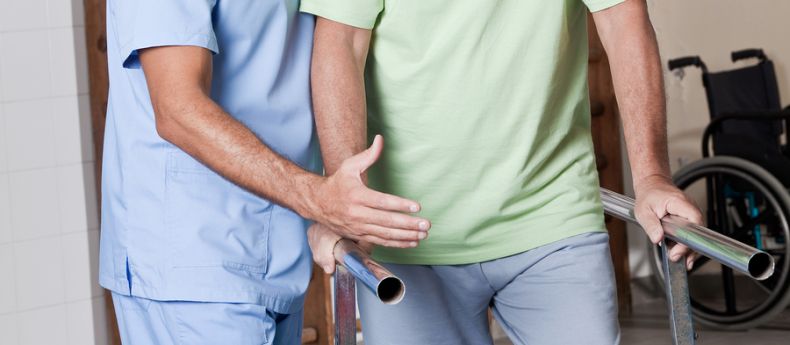
Rehabilitation: An Investment in Your Future
China is seeing a growing demand for Rehabilitation Medicine. Studies show that the number of visits to Rehabilitation Departments of Chinese hospitals in 2011 reached nearly 17 million, which is about 2.3 million more than the number of visits the year before, an increase of about 15%. Chinese people used to hold an erroneous view of Rehabilitation Medicine stemming from the collective idea that only two outcomes could result from having a disease: complete recovery or death. Few people gave much thought to the not uncommon condition of living with a functional impairment. After former Phoenix Channel broadcaster Liu Hairuo suffered a car accident, the nation was astounded by her miraculous recovery and was introduced the idea of neurological rehabilitation. News reports of former U.S. president George H.W. Bush returning to work a few days after a stent procedure for his myocardial infarction also brought attention to this important specialty.
The Chinese perspective of Rehabilitation Medicine is undergoing a radical shift. Medical disciplines such as Cardiology and Orthopedic Surgery are now well-known, but few understand the role of a Rehabilitation Medicine Department. Many think the field is little more than massage therapy, but rehabilitation encompasses so much more.
What is Rehabilitation Medicine?
Rehabilitation Medicine focuses on addressing functional impairment, or rather, the recovery of function. The goal of our treatments is the maximum recovery of functional potential and helping patients resume their normal life activities. Treatments can be classified by the function they aim to recover. These treatments include neurological rehab, orthopedic rehab, spine rehab, cardiac rehab, rehab for cerebral palsy, various forms of geriatric rehab, and rehab for pain (e.g., neck, shoulder, hip, leg, etc.). Our general treatment courses involve physical guidance for functional recovery, the use of orthotics and assistive equipment for functional compensation, and/or the use of devices, such as prosthetics and wheelchairs, as functional substitutes.
Partnering with you on the road to wellness
Rehabilitation Medicine does not stand alone. Multidisciplinary healthcare is foundational to the development of Rehabilitation Medicine. Similarly, Beijing United Family Rehabilitation Hospital (BJURH) is not an isolated health services provider. Every BJURH patient is served by a multidisciplinary healthcare team, usually consisting of the patient’s primary physician and/or surgeon who helps to ensure continuity of care and advises the rehab team on the patient’s condition and medical needs; a rehabilitation physician and/or therapist who evaluates the patient’s functional abilities, helps to design the treatment plan, and oversees its implementation; nurses who provide one-to-one care that supports the rehabilitation treatment; and a psychological therapist and a nutritionist who provide emotional support and nutritional counseling. However, the most important part of a patient’s healthcare team is their family. A patient’s determination to make it through a rehab course is intimately connected with familial support. We aim to create a home-like environment for our patients in the clinic, but to do this well, we need family members to be enthusiastic participants in their loved ones’ recovery process. To this end, a Patient Services representative will also be involved to act as a bridge between patients, their families, and their healthcare teams, continually asking patients and family members how they are responding to the rehab process.
Neurological rehabilitation:
As China’s population ages, the occurrence of diseases affecting cardiopulmonary blood vessels will continue to increase, with stroke being the most common. Medical advances have greatly increased post-stroke life expectancy, but 70-80% of stroke survivors live with functional impairments (e.g., difficulties with movement, sensation/perception, speech, swallowing, recognition, etc.). For stroke victims, especially hemiplegics, the complementarity of pharmaceutical and rehabilitative treatments can greatly enhance recovery.
Orthopedic rehabilitation:
An artful orthopedic surgery achieves optimal results only when followed by rehabilitative therapy. After surgery, the patient’s bones may have healed or stabilized, but they often experience impaired joint function. For these patients, recovery of function and strength does not happen without intentional effort. A professional rehabilitation team provides specific guidance and equipment for building strength and achieving recovery goals.
Gastrointestinal rehabilitation:
Many bed-ridden patients are susceptible to stress ulcers. This is because lying down can triple your body’s secretion of adrenocortical hormones, which induce the formation of stress ulcers. Therefore, this is a hormonal issue, not an appetite problem. Stated another way, the reason bed-ridden patients have such poor appetites is that the patient’s adrenal glands are over-secreting certain hormones and normal intestinal movement (also known as peristalsis) is reduced. Under normal conditions, every step we take “moves” our intestines, aiding peristalsis to promote digestion. Being bed-ridden removes the source of this digestive aid, and these patients experience decreased appetite to compensate for their sluggish digestion. Rehabilitation can help solve this problem by using equipment to help patients engage in walking therapy even if they do not have full use of their limbs. This therapy will, in turn, exercise the intestines. Even if the patient cannot walk, helping them into an upright or semi-upright position will inhibit the over-secretion of adrenocortical hormones.
Does this mean that rehab is only for patients recovering from serious diseases or injuries? Absolutely not. As an example, pregnancy and birthing involves a great deal of physiologically change, especially regarding a woman’s muscles, bones, and hormones. Many women develop lower back pain and hypertension and have no idea that these conditions can be ameliorated through rehabilitation therapy. Regular walking and strengthening your core muscles during pregnancy can make the birthing process much smoother. For post-partum women who want to change their figure, rehab can be a great help, especially for women who engage in the practice of yuezi (traditional Chinese post-partum recovery during the month immediately after delivery). Even after leaving the hospital, a Rehabilitation Physician can provide suggestions for exercises that can be done at home. Additionally, BJURH offers a post-partum recovery package that includes core strength evaluations and pelvic floor strength evaluations to help post-partum women recover functionality and keep up with their new babies.
Rehabilitation as an investment
The World Report on Disability, published by the World Health Organization, concludes that rehabilitation is a worthwhile investment because it creates human capital. This statement expresses the idea that rehabilitation is an investment in ourselves and in our community through the roles every individual uniquely plays in society. Many people are interested in financial management and stocks as a way of making great financial gains with a comparatively small financial expenditure. We should view rehabilitation in a similar light, as a way of making great physiological gains with a similarly comparatively small expenditures. Through rehabilitation therapy, many people with functional impairments can experience functional recovery and recover the joy of reaping health-related dividends.
Copyright United Family Healthcare 2014 All right reserved - 京卫网审[2014]第1927号 - 京ICP备13017554号-4



